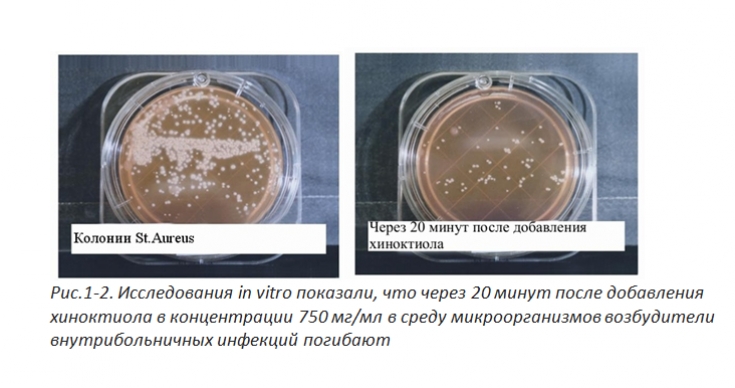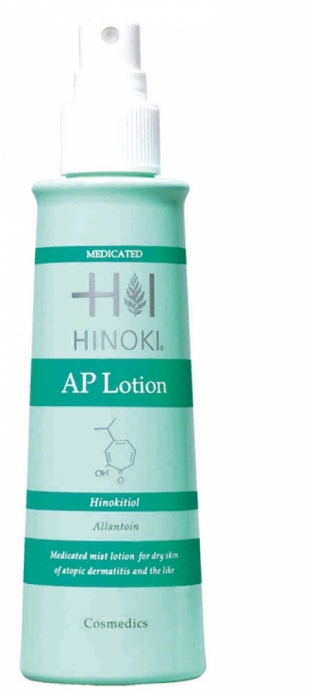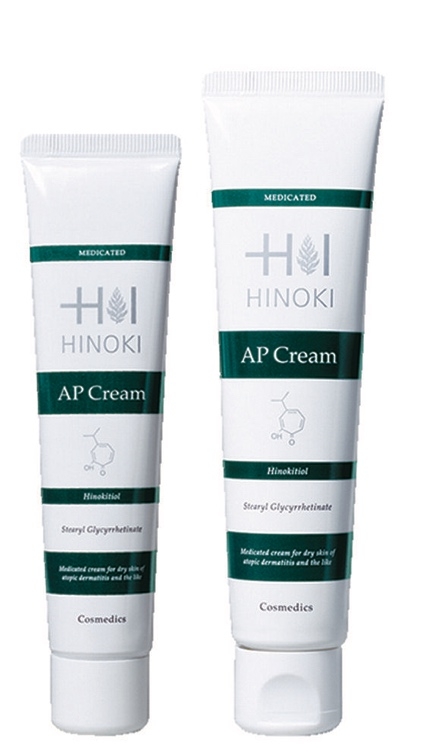Skin care for atopic dermatitis – a difficult task that requires a gentle and careful approach. The cosmetics used in this case should strengthen the skin barrier, maintain a slightly acidic pH of the skin, prevent colonization by pathogenic microflora and the development of the inflammatory process. The Japanese company HINOKI Clinical has developed a line of cosmeceutical products based on active natural ingredients, which have shown a good effect in achieving stable remission in atopic dermatitis.
Elena Balym, a dermatocosmetologist, mesotherapist, certified trainer and expert from Mesopharm and HINOKI Clinical, told estet-portal.com readers about them in more detail.
What is atopic dermatitis and what is its peculiarity?

Atopic dermatitis (ed. - further AD) – This is a skin disease characterized by a recurrent course, a decrease in the barrier properties of the skin, the development of pathological dryness, itching. Against the background of the disease, inflammatory reactions and hypersensitivity to various stimuli develop. Someone has an increased sensitivity to house dust, someone has – to animal fur. In some cases, allergens can be certain foods, such as fruits or protein-containing meals. Often the cause of atopic dermatitis is the chemical components found in building materials or household chemicals.
Intolerable pruritus may subsequently be complicated by secondary staphylococcal and streptococcal infections. This condition occurs in people of different age groups, often manifests itself in childhood, including in infancy, and usually runs in families. The development of this disease is characterized by seasonality: deterioration in the cold season and improvement in summer.
How does atopic dermatitis manifest itself and what mechanisms underlie its development?
Violation of the barrier function of the skin in atopic dermatitis (hereinafter - AD) is associated with a change in the state of the stratum corneum of the epidermis due to a violation of the quantitative and qualitative composition of its lipids. There is a decrease in the level of ceramide 1, which is involved in maintaining the lipid layer and the formation of a protective skin reaction when exposed to irritants. The amount of free fatty acids increases, the content of the components of the natural moisturizing factor of the skin decreases. All this together leads to transepidermal water loss. Dehydration of the epidermis activates the process of restoring its lipids.
When recovery fails and immunity decreases, the skin undergoes a massive attack from pathogenic microflora that damages skin cells. In response to this, keratinocytes produce pro-inflammatory cytokines IL-1a, TNFa, which trigger and maintain the inflammatory process and activate the hyperproduction of free radicals. They exacerbate cell damage, dehydration, and lipid degradation. Thus, the circle of pathological changes in the epidermis closes, dryness, hyperreactivity, areas of peeling, exudative or lichenoid rashes appear.
What methods and means do you recommend to use for the treatment of AD?
The treatment regimen for atopic dermatitis is always determined on an individual basis and may include anti-inflammatory drugs, topical glucocorticosteroids, topical calcineurin inhibitors, moisturizers.
In addition, a special diet must be followed. The treatment of atopic dermatitis has several goals:
• elimination of the cause - factors causing exacerbation;
• external anti-inflammatory therapy;
• medical and cosmetic skin care.
Skin with AD is usually overly sensitive and requires special attention and care in treatment.
AD skin requires special daily care during all phases of the development of the disease, which helps to achieve and maintain remission.
External therapy plays an important role in the treatment of AD.
What are the criteria for daily skin care products for AD skincare?
Cosmetics for the care of atopic skin must meet the following criteria:
• do not contain potential allergens and aggressive components;
• have a slightly acidic pH and restore the lipid structures of the stratum corneum and the hydrolipidic mantle;
• reduce transepidermal water loss;
• provide a pronounced moisturizing, anti-inflammatory effect;
• promote good penetration of active ingredients into the skin;
• Easy to spread on the skin without leaving a greasy sheen.
Currently, there are not many drugs that are acceptable for use in AD. But one of these atopic skin care products is the "AP" line. (hey-pee) of the Hinoki Shinyaku company (HINOKI Shiniyaku), which is based on hinoktiol. This line of products is represented by Mesopharm.
What is quinocthiol and what is its specialty?
This unique substance was isolated from Taiwanese cypress by the Japanese professor Nozoe Tetsuo back in 1936 and attracted the attention of scientists around the world for its pronounced bactericidal and anti-inflammatory properties.
Hinoctiol is effective against most pathogens of nosocomial infections, including methicillin-resistant Staphylococcus aureus, which often worsens the condition of patients with AD.

Later, other equally important properties of this unique substance were discovered:
• ability to penetrate deeply into tissues,
• activate fibroblasts and enhance collagen production,
• have a pronounced whitening effect (inhibits tyrosinase, accelerates the process of renewal of melanin-containing keratinocytes),
• activate the expression of the sirtuin-1 gene, known as the "youth gene".
Until now, the properties of quinocthiol are actively studied by scientists around the world. At present, when resistance to many antibiotics is developing, the bactericidal properties of quinocthiol are especially relevant.
What is special about HINOKI cosmeceuticals and the company's approach to atopic skin care?
In skin care, especially in AD, it is very important to properly and gently cleanse the skin. When washing with a non-selective detergent, along with impurities, their own lipid components of the skin, which are already lacking in atopy, are washed off, and its barrier function worsens even more. Therefore, it is very important to choose the right products.
Hinoki Shinyaku Company developed a three-step skin cleansing:
• first stage – removing oil-soluble impurities with Moist Clear Oil,
• second stage – cleansing the skin of water-soluble impurities with AP Foam,
• third stage – restoration of pH after contact with water with AP Lotion.
Moist Clear Oil contains a complex of plant components and oils that prevent skin dryness, effectively dissolves and removes fat-soluble impurities, while preserving the lipid structures of the stratum corneum and hydro-lipid mantle. The fatty components of these oils are similar to the lipid structures of the skin. Moist Clear Oil contains chinocthiol, squalane, jojoba oil, olive oil, meadowfoam oil, shea butter, bisabolol, sage extract, ascorbic acid, stearyl glycyrrhetinate.
Tell us more about the AR line of drugs?
AP line is a face and body skin care product when there is a problem of atopy or other conditions of a dermatitis nature. It includes three products: AP Foam Cleanser, AP Lotion, AP Cream.

Healing foam «AP Foam» - multifunctional, slightly acidic pH, selective detergent, contains a powerful complex of quinocthiol, licorice root glycyrrhizinate and tea tree oil.
It has an anti-inflammatory, wound-healing, immunostimulating effect, and also prevents the growth of pathogenic bacteria, including Staphylococcus aureus.
Already 1 hour after using the product, the number of bacteria decreases by 92.3%, and after 3 hours – by 96.7% (in vivo studies).

Regenerating lotion «AP Lotion» has a buffering effect, restoring the pH of the skin. The gamma-glutamic acid polypeptide is part of the NMF, supports the moisture-retaining and protective functions of the skin.
The combination of quinocthiol, gamma-aminocaproic acid and allantoin provides a pronounced anti-inflammatory and bactericidal effect. In this product, quinocthiol is placed in a sugar-based capsule, which makes it possible for it to exhibit bactericidal properties for a long time. 4 hours after applying the lotion to the skin, St. Aureus is practically absent on the skin and this effect persists for 8 hours (in vivo studies).

 AP Cream – multifunctional. It contains a lot of quinocthiol and has strong antibacterial and bacteriostatic properties, inhibits the growth of bacteria, including St. Aureus, on the surface of the skin and provides a quick recovery of the skin.
AP Cream – multifunctional. It contains a lot of quinocthiol and has strong antibacterial and bacteriostatic properties, inhibits the growth of bacteria, including St. Aureus, on the surface of the skin and provides a quick recovery of the skin.
Squalane in combination with stearyl glycyrrhetinate softens the skin and has an anti-inflammatory effect.

The healing properties of AR cream have been confirmed by a number of studies at Tohoku University (Japan) under the guidance of Prof.
Tagami (Department of Internal Medicine, Tohoku University Graduate School of Medicine Released 2010/08/25).
As a result of in vivo studies, the high bactericidal ability of the AP cream, as well as its pronounced moisturizing properties, was confirmed. The number of Staphylococcus aureus after applying the cream for 2 weeks decreased by almost 2 times.
Another study was conducted on the basis of the Moscow Medical Academy. Sechenov and the St. Petersburg Center for Aesthetic Medicine under the guidance of prof. Smirnova G.I. and Ch. doctor Doshchuk V.I.
These studies concluded that there was a significant reduction in flushing and dryness of the skin when using the complex of AR foam and AR cream in children; no signs of inflammation after 3-4 days of use in adults with mild AD. In severe cases of the disease, as a monotherapy, AR cream is ineffective and requires the addition of other groups of drugs (anti-inflammatory, desensitizing).
The use of the cream is safe, does not cause side effects and allergic reactions. Easily tolerated by all age groups, can be used on children's skin without fear.
Skin care for AD very difficult. The main task of dermatocosmetics proposed by Mesopharm, – strengthen the skin barrier, maintain skin homeostasis, maintain its integrity, health and beauty. Using the healing power of nature and a scientific approach to the treatment of patients with atopic dermatitis, it is possible to achieve stable remission at any age and maintain skin health for a long time.







Add a comment